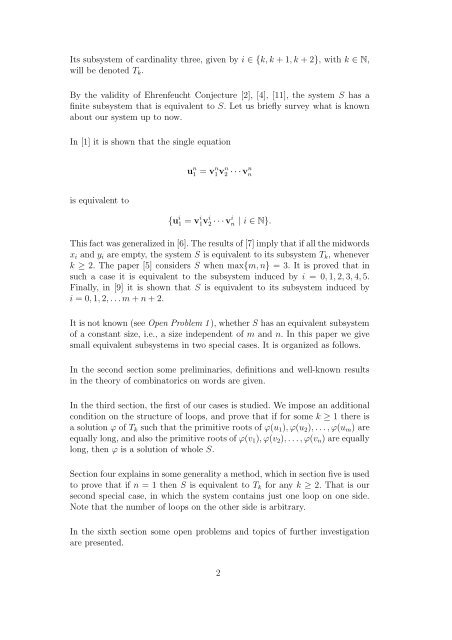On systems of word equations with simple loop sets
On systems of word equations with simple loop sets
On systems of word equations with simple loop sets
You also want an ePaper? Increase the reach of your titles
YUMPU automatically turns print PDFs into web optimized ePapers that Google loves.
Its subsystem <strong>of</strong> cardinality three, given by i ∈ {k, k + 1, k + 2}, <strong>with</strong> k ∈ N,<br />
will be denoted T k .<br />
By the validity <strong>of</strong> Ehrenfeucht Conjecture [2], [4], [11], the system S has a<br />
finite subsystem that is equivalent to S. Let us briefly survey what is known<br />
about our system up to now.<br />
In [1] it is shown that the single equation<br />
u n 1 = v n 1v n 2 · · ·v n n<br />
is equivalent to<br />
{u i 1 = v i 1v i 2 · · ·v i n | i ∈ N}.<br />
This fact was generalized in [6]. The results <strong>of</strong> [7] imply that if all the mid<strong>word</strong>s<br />
x i and y i are empty, the system S is equivalent to its subsystem T k , whenever<br />
k ≥ 2. The paper [5] considers S when max{m, n} = 3. It is proved that in<br />
such a case it is equivalent to the subsystem induced by i = 0, 1, 2, 3, 4, 5.<br />
Finally, in [9] it is shown that S is equivalent to its subsystem induced by<br />
i = 0, 1, 2, . . .m + n + 2.<br />
It is not known (see Open Problem 1), whether S has an equivalent subsystem<br />
<strong>of</strong> a constant size, i.e., a size independent <strong>of</strong> m and n. In this paper we give<br />
small equivalent sub<strong>systems</strong> in two special cases. It is organized as follows.<br />
In the second section some preliminaries, definitions and well-known results<br />
in the theory <strong>of</strong> combinatorics on <strong>word</strong>s are given.<br />
In the third section, the first <strong>of</strong> our cases is studied. We impose an additional<br />
condition on the structure <strong>of</strong> <strong>loop</strong>s, and prove that if for some k ≥ 1 there is<br />
a solution ϕ <strong>of</strong> T k such that the primitive roots <strong>of</strong> ϕ(u 1 ), ϕ(u 2 ), . . ., ϕ(u m ) are<br />
equally long, and also the primitive roots <strong>of</strong> ϕ(v 1 ), ϕ(v 2 ), . . .,ϕ(v n ) are equally<br />
long, then ϕ is a solution <strong>of</strong> whole S.<br />
Section four explains in some generality a method, which in section five is used<br />
to prove that if n = 1 then S is equivalent to T k for any k ≥ 2. That is our<br />
second special case, in which the system contains just one <strong>loop</strong> on one side.<br />
Note that the number <strong>of</strong> <strong>loop</strong>s on the other side is arbitrary.<br />
In the sixth section some open problems and topics <strong>of</strong> further investigation<br />
are presented.<br />
2
















